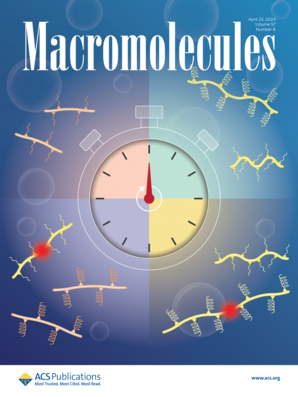基于聚聚体(o)ide AB3 mitoarm Star聚合物胶束核交联与π- π相互作用的结合
IF 5.1
1区 化学
Q1 POLYMER SCIENCE
引用次数: 0
摘要
纳米载体缺乏稳定性,药物在血液中过早释放,以及由此产生的不良反应,通过影响其治疗效果,极大地阻碍了纳米药物的发展。为了超越这些限制,充分挖掘聚合物胶束靶向给药的潜力,人们设计了各种物理和化学策略来改善胶束血液循环时间,提高药物保留率。在这方面,基于胶束的mitoarm星型聚合物在亲疏水界面上的聚合物密度的提高是非常吸引人的,并将它们与传统的线性嵌段共聚物区分开来。然而,不对称结构的复杂合成往往阻碍了纳米医学领域的广泛应用。在本研究中,我们通过优化正交群策略,引入核心交联性和π- π相互作用,设计了新的双稳定PeptoMiktoStars。这些多肽(o)ide mitoarm星形聚合物将聚(s -乙基磺酰基-l-半胱氨酸)(pCys(SO2Et))/聚(s -乙基磺酰基-l-同型半胱氨酸)(pHcy(SO2Et))和聚(γ-苄基-l-谷氨酸(pGlu(OBn)))的多肽块与多肽类聚arcos (pSar)的多个臂在AB3结构中统一起来。通过1H NMR、1H DOSY和GPC等手段证实了星形聚合物的形成。得到的结果显示出分子量分布窄,分散度低(Đ = 1.16-1.18)的星形结构,并能精确控制聚合度。在核心交联和药物包封成功后,通过动态激光散射(DLS)和透射电子显微镜(TEM)观察到均匀的胶束,其流体动力学直径在60至68 nm之间,使这些结构适合局部或全身给药时控制细胞内药物释放。本文章由计算机程序翻译,如有差异,请以英文原文为准。

Combining Core Cross-Linking and π–π-Interactions in Polymer Micelles Based on Polypept(o)ide AB3 Miktoarm Star Polymers
The lack of stability in nanocarriers, premature release of drugs in the bloodstream, and the resulting adverse effects have greatly hindered the advancement of nanomedicines by comprising their therapeutic effectiveness. In order to surpass these limitations and fully exploit the potential of polymeric micelles for targeted drug delivery, various physical and chemical strategies have been devised to improve micellar blood circulation time and improve drug retention. In this regard, the improved polymer density at the hydrophilic/hydrophobic interface in miktoarm star polymers based micelles is highly appealing and sets them apart from conventional linear block copolymers. Nonetheless, the often complex synthesis of asymmetric architectures hinders a broader application in the field of nanomedicine. In this study, we have designed novel dual-stabilizable PeptoMiktoStars by optimizing the orthogonal group strategy, introducing core cross-linkability and π–π-interactions. These polypept(o)ide miktoarm star polymers unify the polypeptide blocks of poly(S-ethylsulfonyl-l-cysteine) (pCys(SO2Et))/poly(S-ethylsulfonyl-l-homocysteine) (pHcy(SO2Et)) and poly(γ-benzyl-l-glutamate (pGlu(OBn))) with multiple arms of the polypeptoid polysarcosine (pSar) in an AB3 architecture. By utilizing 1H NMR, 1H DOSY, and GPC, the formation of well-defined star polymers was confirmed. The obtained results showcased star structures with narrow molecular weight distributions, low dispersities (Đ = 1.16–1.18), and accurate control over the degree of polymerization. After successful core cross-linking and drug encapsulation, uniform micelles with hydrodynamic diameters ranging from 60 to 68 nm were observed by dynamic laser light scattering (DLS) and transmission electron microscopy (TEM), making these structures suitable for controlled intracellular drug release upon local or systemic administration.
求助全文
通过发布文献求助,成功后即可免费获取论文全文。
去求助
来源期刊

Macromolecules
工程技术-高分子科学
CiteScore
9.30
自引率
16.40%
发文量
942
审稿时长
2 months
期刊介绍:
Macromolecules publishes original, fundamental, and impactful research on all aspects of polymer science. Topics of interest include synthesis (e.g., controlled polymerizations, polymerization catalysis, post polymerization modification, new monomer structures and polymer architectures, and polymerization mechanisms/kinetics analysis); phase behavior, thermodynamics, dynamic, and ordering/disordering phenomena (e.g., self-assembly, gelation, crystallization, solution/melt/solid-state characteristics); structure and properties (e.g., mechanical and rheological properties, surface/interfacial characteristics, electronic and transport properties); new state of the art characterization (e.g., spectroscopy, scattering, microscopy, rheology), simulation (e.g., Monte Carlo, molecular dynamics, multi-scale/coarse-grained modeling), and theoretical methods. Renewable/sustainable polymers, polymer networks, responsive polymers, electro-, magneto- and opto-active macromolecules, inorganic polymers, charge-transporting polymers (ion-containing, semiconducting, and conducting), nanostructured polymers, and polymer composites are also of interest. Typical papers published in Macromolecules showcase important and innovative concepts, experimental methods/observations, and theoretical/computational approaches that demonstrate a fundamental advance in the understanding of polymers.
 求助内容:
求助内容: 应助结果提醒方式:
应助结果提醒方式:


